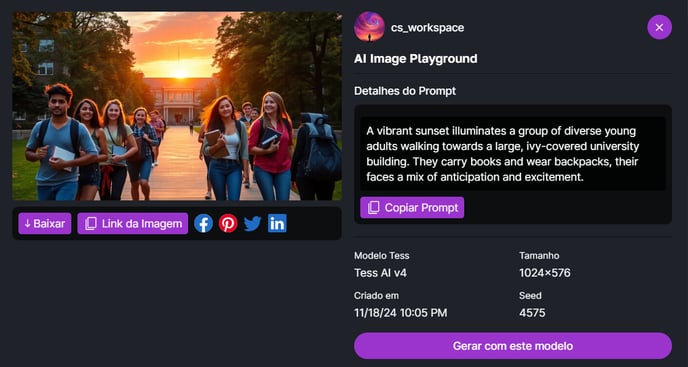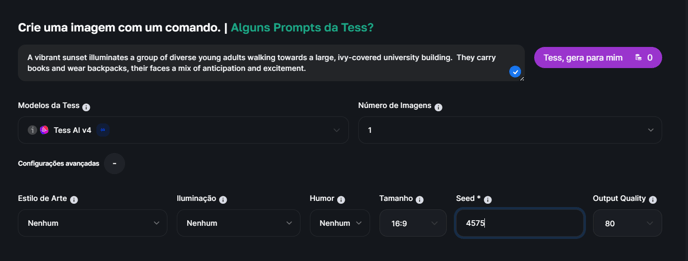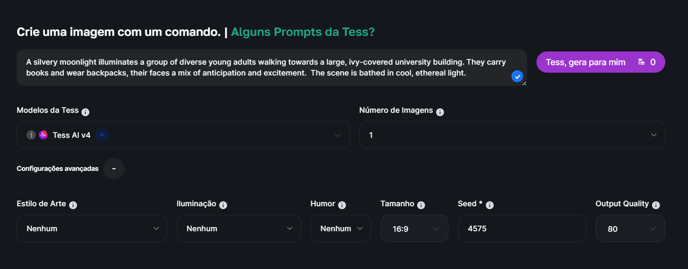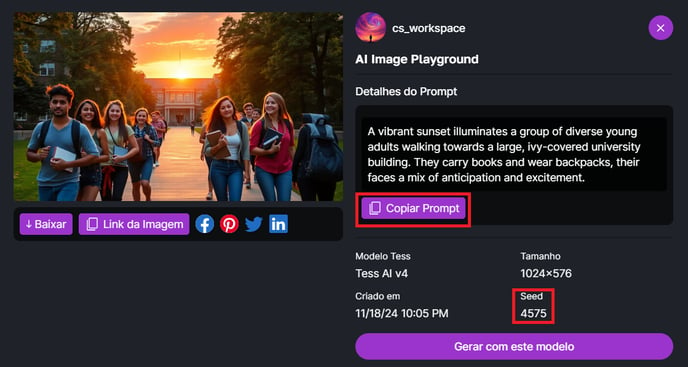Image generation with artificial intelligence (AI) has totally changed how we create and engage with visual content. In this context, the seed has become an essential tool for artists, designers, and enthusiasts, offering an unheard-of level of control over the creative process.
Basically, a seed is a number that acts as a starting point for the AI algorithms that generate images. Think of it as a unique "fingerprint" for each image.
When you enter a prompt (a text description) into an AI, along with a specific seed, the algorithm uses that number as the base for creating the image.
This means that if you use the same prompt and the same seed, you'll get really similar visual results, even though small differences can show up thanks to the probabilistic nature of diffusion algorithms.
Generating an image without a seed:

Notice that the seed is set to zero when the image is generated.
The result:

Now, with the same prompt, but this time filling in the seed field, I'm gonna generate an image:

Notice that the images turn out pretty much the same when we use the seed code to generate the second image:

The Power of Reproduction and Refinement
The big advantage of seed is its ability to reproduce images with high fidelity. This is crucial for refining a visual concept.
Imagine you generated an image you're happy with, but it needs a few tweaks. By keeping the seed and just changing the prompt, you can explore different versions of the image while keeping its main features like composition, color palette, and overall style. This precise way to iterate lets you get to your perfect image way more efficiently.
In the example below, we'll change the prompt but use the seed from the previously generated image:
The result with a few image tweaks:

Easy Collaboration & Sharing
Besides individual control, the seed also makes teamwork between creators easier. When you share the seed and the prompt you used, you let other people recreate your image exactly. This opens up ways to swap ideas, experiment as a group, and build images together, making the whole creative process way more dynamic and interactive.
To copy the prompt used, just click on the generated image and after expanding the image, copy the prompt and seed as shown:

Exploring the Creative Possibilities of Seed
The versatility of seed stretches across a bunch of creative uses:
Consistency in Series: If you want to make a series of images with similar visual elements, like characters or settings, the seed keeps the whole set looking consistent.
Style Discovery: Try out different seeds using the same prompt to see what kind of visual interpretations you can get from the same idea. Doing this might help you find new styles and fresh approaches.
Precise Control: The seed gives you detailed control over the generation process, letting you make subtle tweaks and refinements that would be tough to get just by tweaking the prompt.
The seed is more than just a simple number; it's the key to unlocking the creative potential of image-generating AIs. By mastering how to use the seed, you take control of the process, exploring new possibilities and getting visual results that are more refined, consistent, and in line with your artistic vision.
Use the seed when generating images with AI in these situations:
Goal: Improve an existing image without losing its main features.
Situation: You generated an image that's almost perfect, but you need to tweak details like lighting, colors, or the placement of elements.
How to use: Keep the original seed and edit the prompt, adding or changing whatever details you want. The AI will make variations of the original image, so you can pick the one that fits your needs best.
Goal: Keep a consistent look across a set of images.
Situation: You're making characters for a game, illustrations for a book, or any project that needs a unified visual style.
How to use: Use the same seed for all images in the series. Change the prompt to create variations on the character, object, or scene while keeping the style and overall vibe consistent.
Goal: Try out different visual approaches for the same concept.
Scenario: You have an idea in mind, but you're open to exploring different art styles, color palettes, and compositions.
How to use: Keep the prompt fixed and try different seed values. Each seed will give you a unique visual take on your prompt, so you can discover new options and find the perfect look for your project.
Goal: Share and replicate images accurately.
Scenario: You want to share your work with other creators, get some feedback, or let collaborators work from your base image.
How to use: Share the prompt and seed you used. Anyone with access to an image-generating AI can recreate your image precisely, making sure everything stays consistent and collaboration is easy.